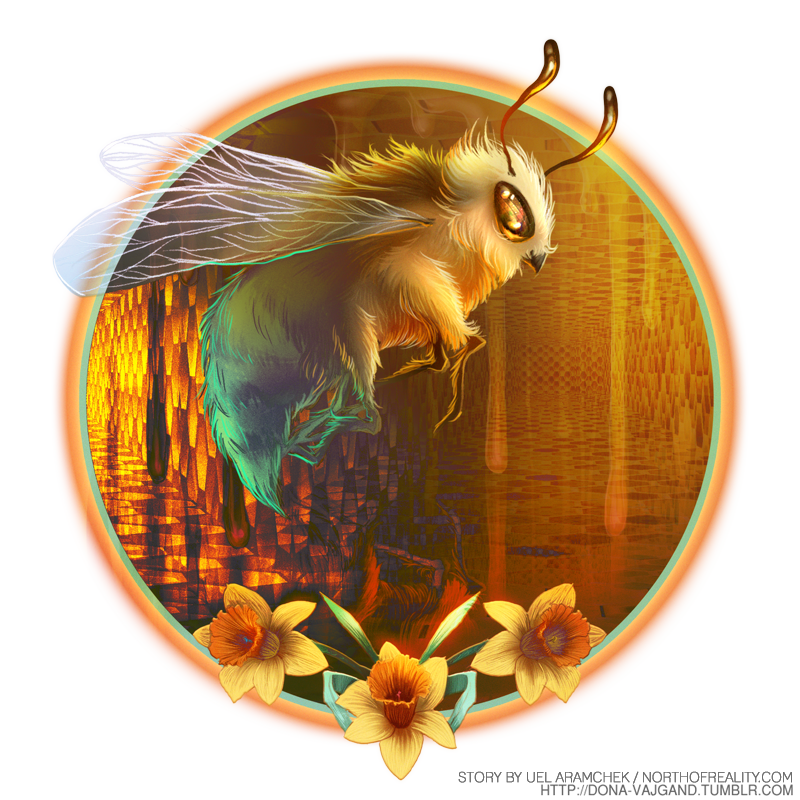The jar of Kraken’s ink on the shelf appears slightly more transparent than the empty space that surrounds it. The glass itself seems to have no thickness, and along some parts of its surface, appears to not even exist at all. This is because unlike other species of squid whose ink absorbs light, the Kraken’s ink rejects light altogether, and spits it out slightly faster than the speed at which it entered.
When the ink is allowed to cling to an opaque substance, its effects are more readily apparent. Rather than obscuring color, it instead corrupts it; the wavelength of reflected light becomes wildly unstable, resulting in a glittering pointillism more complex than the human visual cortex can process. To gaze into this chaotic rainbow for more than a few seconds can result in significant brain trauma.
This plays a key role in the tactics used by the Kraken to attack ocean-bound vessels. Before wrapping its tentacles around the hull, it allows itself to drift just beneath the water’s surface in parallel with the ship’s path. Then, once in range, its ink-jets spray across the starboard side diagonally, painting the masts with a thousand maddening colors. Those above deck are forced to close their eyes or lose their minds; those below can choose to either join them, or wait to be devoured.
How such a singular creature came to exist is not immediately clear; with no natural predators and only seafarers as its prey, it seems as though it could have only come into existence after the emergence of mankind. This hypothesis is further evidenced by the organic weaponry stored inside its body, which seems specialized to exploit the anatomy of creatures with complex brains that live in the path of direct sunlight. Perhaps most compellingly, human bodies provide far too little biomass to sustain such a colossal monster’s diet; as such, its metabolism seems instead to be reliant on the slow digestion of timber.
This evidence has led to the superstition that mankind brought the Kraken to life through storytelling and artwork. A more realistic hypothesis, though perhaps just as far-reaching, is that this lonely beast is the only remaining survivor of a lost era, when monsters like it were plentiful, and adapted specifically to hunting our kind.
Strange as the Kraken's ink may be, cuttlefish ink is even stranger.
Though her age is incalculable, Charybdis may also be a survivor of this era.
As whiskey ages, there is always an amount that evaporates from within the barrel, referred to by those who produce it as "the angel's share." Despite the beverage’s association with sin, its manufacturing is one path by which mankind can barter with the heavens; a large enough tithe of fine Bourbon can bring with it returns of divine favor and forgiveness.
When Narcissus gazed into the pond, and saw the wonder of the universe in the beauty of his own reflection, all meaning was drained from his physical flesh. At that exact moment of realization, he withered into nothingness, for his image had superceded his presence in reality. A single flower grew in his place, one which bore his name, and its own reflection served as its roots.
Among scorpions, there exists a religion not of tradition, but rather, one of instinct. Though they lack the neurological sophistication required to comprehend such concepts as God or eternity, their genetic memory leaves just enough room to accommodate one curious ritual.
Phlebic White was originally marketed to the public as “the world’s first intelligent lubricant,” a slogan which holds to this day. Rather than passively facilitating motion in the same manner as oil or grease, this pearlescent substance does so actively. Every droplet of the fluid contains millions of individual, microscopic cells, which wobble, throb, and vibrate when exposed to heat. They learn from repetitive motion, as well as from interactions with one another, allowing them to become a churning milk of pressurized horsepower.
Every now and then, the owl in the bottle pretends to be solid. It presses its wandering eyes against the inner surface of the glass, watchful and eager, searching the room for prey beyond its reach. Eventually, the twin orbs tire of their vigil and swirl away, back into the pool of liquid feathers from which they emerged.
The imported jar is filled to its midpoint with a soft, transparent dust which, according to its label, is a form of “powdered water.” The printed instructions on its reverse are easy to follow:
1. Fill the container to just beneath its lid with liquid water.
2. Insert cork.
3. Shake vigorously for thirty seconds.
Old-fashioned radios produced sound by boiling liquid lightning. The distinctive drone that emerged, of churning static and leaping foam, came to be known as “white noise.” This term is said by some to be arbitrary in origin, though others believe it was derived from the color of the electric vapor that churned through the innards of these devices.
An alluvium of jade velvet can be seen swirling throughout the jar, occasionally catching a glimmer of sunlight. When shaken, the contents appear torn and tattered by the turbulence, yet eventually return to their stable, undifferentiated flow.
There are nine isotopes of elemental fire which can be found in nature, though only five of these are stable. Classical fire, the sort which lights candles and powers engines, consists on the atomic level of exactly eight protons, eight neutrons, and eight electrons. For this reason, it is often mistaken for oxygen during experiments in modern chemistry. Remove one neutron from this arrangement, and the resultant isotope is phlogiston, classical fire’s nearly indistinguishable cousin. Remove yet another neutron, however, and the result is a volatile substance known to natural philosophers as phlox borealis.
It has long been known that the molecular structure of diamond renders it extraordinarily durable. This hardness is actually twofold in nature, however; in addition to resisting external forces, it also prevents the eruption of a deep, internal pressure. When the cubical arrangement of atoms is disrupted, this can cause the release of a substance known as “diamond nectar.”
The black pear remains under extreme pressure after being plucked from its branch; before it can be eaten, it must be pierced with a knife, then allowed to bleed for three days. While the teeth and bones must eventually be removed as well, this drains the majority of the fruit’s venom, allowing those brave enough to consume its pulp directly a chance at survival.
Liquid flowers are the most delicate form of flora, believed by many to not even exist. They congeal from seeds cast into small bodies of water, then bubble to the surface as unstable jets of color and fragrance. Each spherical petal instantly bursts into vapor upon contact with the atmosphere, preventing these frail beings from surviving more than a few seconds in the wild.
A closer look at the fluid inside the jar reveals that it is, in fact, alive. Magnetic ants have formed a colony within, and are living in extremely dense quarters, crawling all over each other’s bodies. It is difficult to discern at a glance where their tunnels end and the insects begin.
Magnetic ink was an intriguing literary innovation, in that it allowed for books to be stored without the use of paper. Through liquid encoding, each cluster of molecules could remember the alphabet and sequence it belonged to previously, allowing the words to arrange themselves autonomously once splattered against a surface. Ultimately, this led to the phenomenon of storing books in jars as pools of undifferentiated ink, where they waited for surfaces upon which to imprint themselves.
The sands of the desert are sweet, for veins of dark sugar twist through its dunes. Down below, metamorphic layers of thick molasses crawl through cracks in ancient bedrock, condensed to ooze by the weight of the world above. In these porous spaces ruled by dust and germ, pools of primordial rum have formed under extreme pressure. It is a liquor that men and machines alike can drink, and it produces similar results in both.
Strange rivers of geothermal activity run beneath Hyperborea’s blue forests. The tender earth liquefies just below human body temperature, and becomes a warm, fluid stone that flows easily through the hands. The local terminology for this substance translates roughly to “world jelly.”
The jar of Kraken’s ink on the shelf appears slightly more transparent than the empty space that surrounds it. The glass itself seems to have no thickness, and along some parts of its surface, appears to not even exist at all. This is because unlike other species of squid whose ink absorbs light, the Kraken’s ink rejects light altogether, and spits it out slightly faster than the speed at which it entered.


